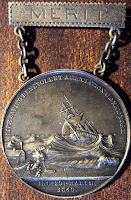Lifesaving Benevolent Association of New York Award Medals
The years 1838 to 1849 saw 338 shipwrecks along the coast of New Jersey and Long Island;
in response to this a group of merchants, ship-owners and other private citizens formed
the Lifesaving Benevolent Association of New York. The purpose of the organization as
stated in the original charter is to “recognize and reward courage, skill and seamanship in the rescue of human life on the sea or any navigable waters … to encourage training in seamanship, lifeboat work, methods of rescue in the water, and the resuscitation of victims of submersion.”.
Working with the newly established U.S. Lifesaving Service they helped construct and
operate life-saving stations along the New York Coastline.
In 1915 the Federal government took control of the stations and they eventually became
the responsibility of the U.S. Coast Guard. The LSBA continued to reward individuals
with monetary compensation, pins and medals to recognize heroism at sea. In 2009
the Seamen's Church Institute took on the administrative duties of the LSBA.
FIRST OBVERSE - Naval scene with ship foundering in rough seas, figures on shore firing a rescue line, small building inscribed Relief, inscription above LIFESAVING BENEVOLENT ASSOCIATION OF NEW YORK, below in exergue INCd 29th MARCH / 1849, in exergue line to left G.H. LOVETT,
to right SCULPT.
SECOND OBVERSE - Similar to die 1 but different details especially in the ship and waves, no SCULPT in exergue line.
FIRST REVERSE - Blank center enclosed by VITA FELICIBUSAUSIS SERVATA above, oak wreath and first ribbon below
SECOND REVERSE - Same as above but with second ribbon.
Unawarded, bronze, 51.2mm
First obverse, second reverse dies
Bronze examples of this medal are much scarcer than either gold
or silver examples and I have not seen one engraved. They were
possibly specimen or trial pieces.
1858 Award Medal Presented to John Johnston
Gold, 51mm
First obverse and reverse dies
First obverse and reverse dies
|
|
|
1902 Award Medal presented to Captain A. Potjer
Gold, 51.2mm
Second obverse and reverse dies
1863 Award Medal presented to Walter Lemon
Silver, 51mm
First obverse and reverse dies
1886 Award Medal Presented to Andre Lorsson
Silver, 51.1mm
First obverse, second reverse dies
First obverse, second reverse dies
|
|
|
no others. In all other first obverse dies I have seen
the line extending from the top of the forward mast is just
a straight line; this one has a thicker, curled line. But
under magnification you can see what appears to be the
straight line found on other first obverse examples.
1896 Award Medal Presented to Francois Saintillan
Silver, 51.1mm
Second obverse and reverse dies
|
|
|
1878 Award Medal Presented to Robert Walsh
Silvered bronze?, 51.1mm, with original pinback
First obverse, second reverse dies
|
|
unawarded example above is 4mm thick, this one is 3mm - the same as the silver.
The weight is 48 grams compared to 41 for the silver. And when "rung"
it has a dull sound very unlike the characteristic silver ring.
I did have the above piece tested by X-Ray Fluorescence and the result
came back 58.2% silver, 41.8% gold! This was done at a precious metal
recycling facility with a fairly reliable and accurate device but the result
is difficult to believe. Further testing is definitely called for.
At first glance it would appear that there is just two dies - one obverse and one reverse.
On closer examination it seems there are two reverse dies and two
obverse dies. The reverse dies differ in the design of the wreath. The obverse dies
differ in the composition of the waves, the design details on the ship, and other small details as well as having the lettering "sculp" to the right on the exergue line.
At first glance it would appear that there is just two dies - one obverse and one reverse.
On closer examination it seems there are two reverse dies and two
obverse dies. The reverse dies differ in the design of the wreath. The obverse dies
differ in the composition of the waves, the design details on the ship, and other small details as well as having the lettering "sculp" to the right on the exergue line.
|
|
First Reverse Die detail
Second Obverse Die details
Second Reverse Die detail





















